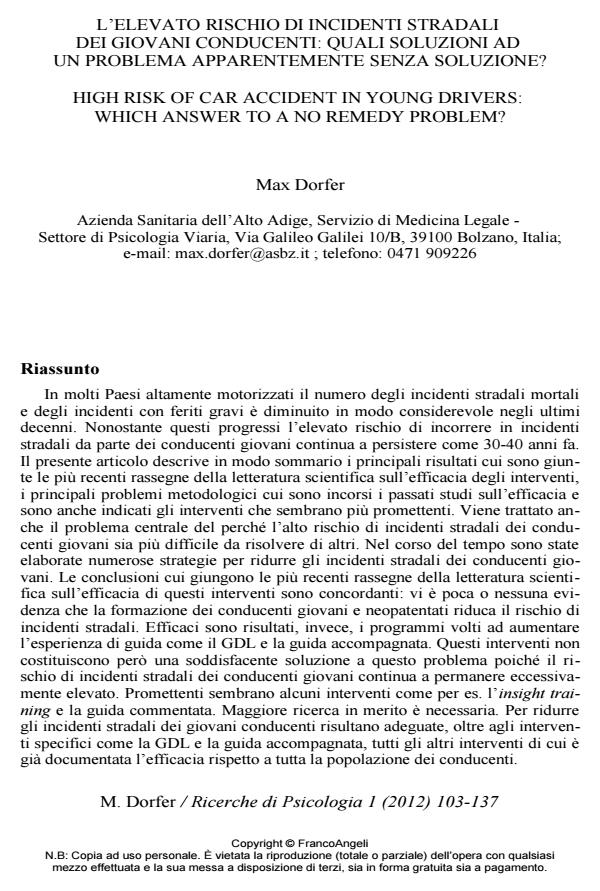L’elevato rischio di incidenti stradali dei giovani conducenti: quali soluzioni ad un problema apparentemente senza soluzione?
Titolo Rivista RICERCHE DI PSICOLOGIA
Autori/Curatori Max Dorfer
Anno di pubblicazione 2013 Fascicolo 2012/1
Lingua Italiano Numero pagine 35 P. 103-137 Dimensione file 848 KB
DOI 10.3280/RIP2012-001006
Il DOI è il codice a barre della proprietà intellettuale: per saperne di più
clicca qui
Qui sotto puoi vedere in anteprima la prima pagina di questo articolo.
Se questo articolo ti interessa, lo puoi acquistare (e scaricare in formato pdf) seguendo le facili indicazioni per acquistare il download credit. Acquista Download Credits per scaricare questo Articolo in formato PDF

FrancoAngeli è membro della Publishers International Linking Association, Inc (PILA)associazione indipendente e non profit per facilitare (attraverso i servizi tecnologici implementati da CrossRef.org) l’accesso degli studiosi ai contenuti digitali nelle pubblicazioni professionali e scientifiche
In molti Paesi altamente motorizzati il numero degli incidenti stradali mortali e degli incidenti con feriti gravi e diminuito in modo considerevole negli ultimi decenni. Nonostante questi progressi l’elevato rischio di incorrere in incidenti stradali da parte dei conducenti giovani continua a persistere come 30-40 anni fa. Il presente articolo descrive in modo sommario i principali risultati cui sono giunte le piu recenti rassegne della letteratura scientifica sull’efficacia degli interventi, i principali problemi metodologici cui sono incorsi i passati studi sull’efficacia e sono anche indicati gli interventi che sembrano piu promettenti. Viene trattato anche il problema centrale del perche l’alto rischio di incidenti stradali dei conducenti giovani sia piu difficile da risolvere di altri. Nel corso del tempo sono state elaborate numerose strategie per ridurre gli incidenti stradali dei conducenti giovani. Le conclusioni cui giungono le piu recenti rassegne della letteratura scientifica sull’efficacia di questi interventi sono concordanti: vi e poca o nessuna evidenza che la formazione dei conducenti giovani e neopatentati riduca il rischio di incidenti stradali. Efficaci sono risultati, invece, i programmi volti ad aumentare l’esperienza di guida come il GDL e la guida accompagnata. Questi interventi non costituiscono pero una soddisfacente soluzione a questo problema poiche il rischio di incidenti stradali dei conducenti giovani continua a permanere eccessivamente elevato. Promettenti sembrano alcuni interventi come per es. l’insight training e la guida commentata. Maggiore ricerca in merito e necessaria. Per ridurre gli incidenti stradali dei giovani conducenti risultano adeguate, oltre agli interventi specifici come la GDL e la guida accompagnata, tutti gli altri interventi di cui e gia documentata l’efficacia rispetto a tutta la popolazione dei conducenti
Parole chiave:Conducenti giovani, neopatentati, formazione alla guida, fattori di rischio, interventi per ridurre gli incidenti stradali, valutazione dell’efficacia degli interventi formativi.
Max Dorfer, L’elevato rischio di incidenti stradali dei giovani conducenti: quali soluzioni ad un problema apparentemente senza soluzione? in "RICERCHE DI PSICOLOGIA " 1/2012, pp 103-137, DOI: 10.3280/RIP2012-001006